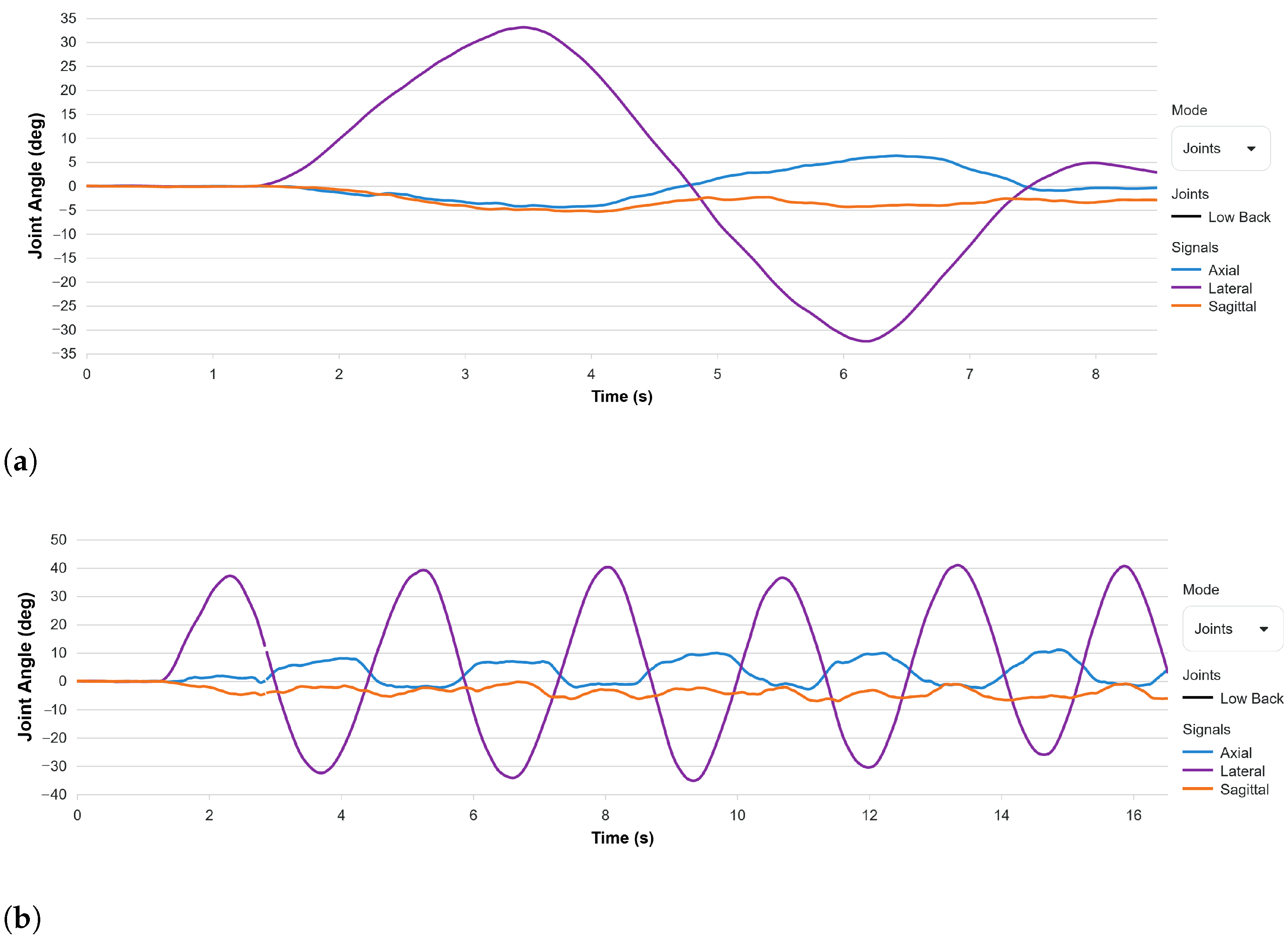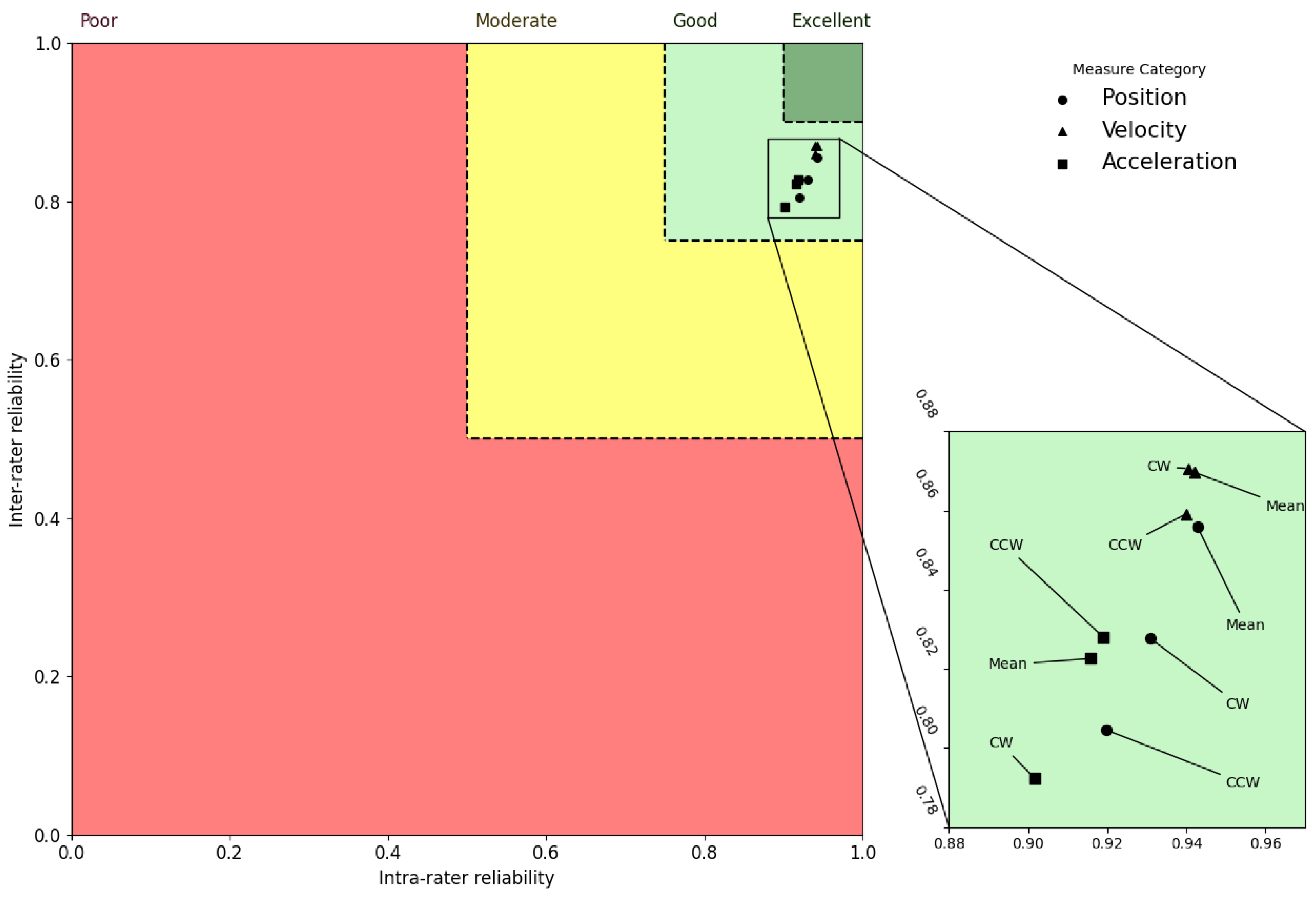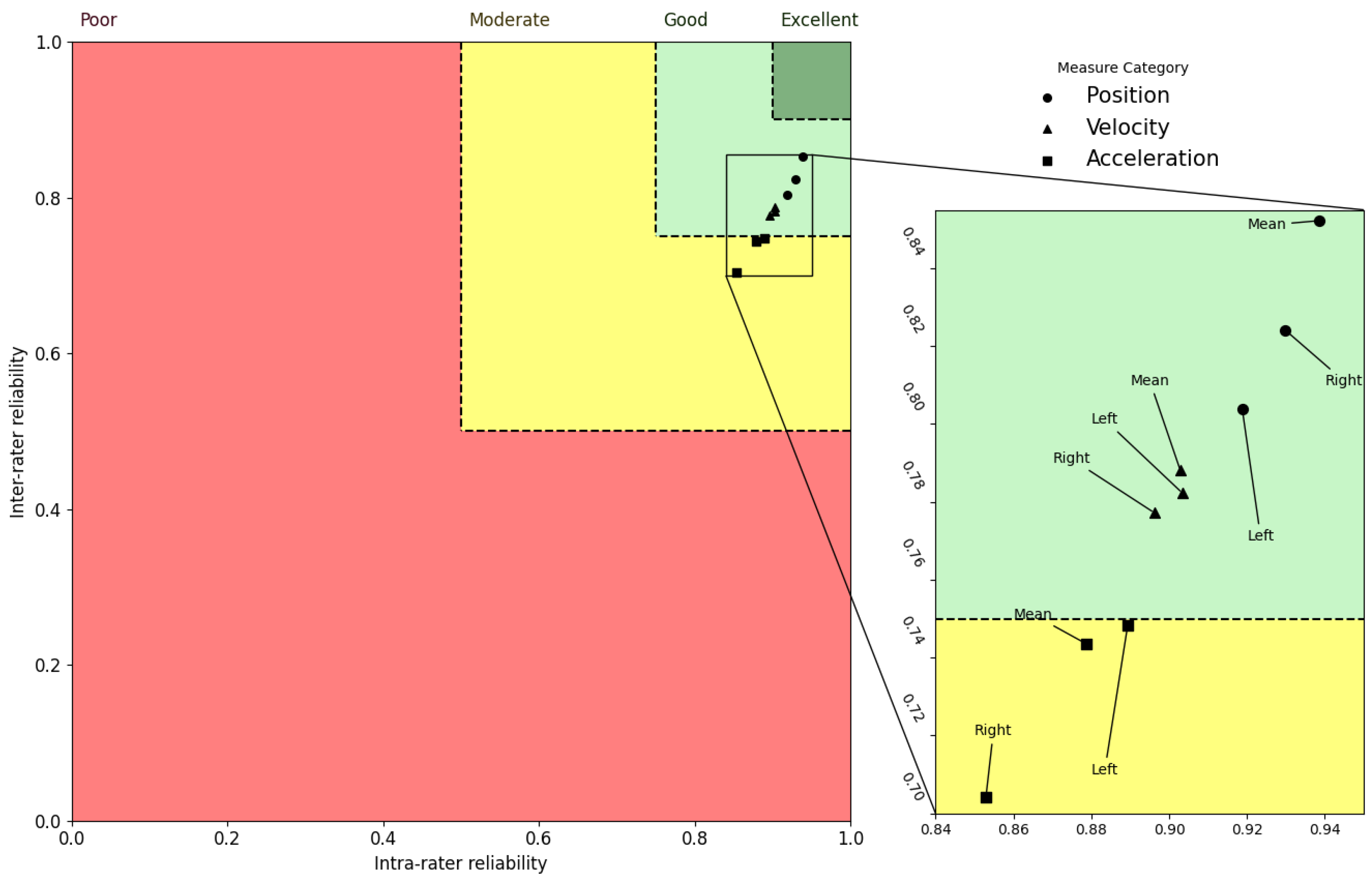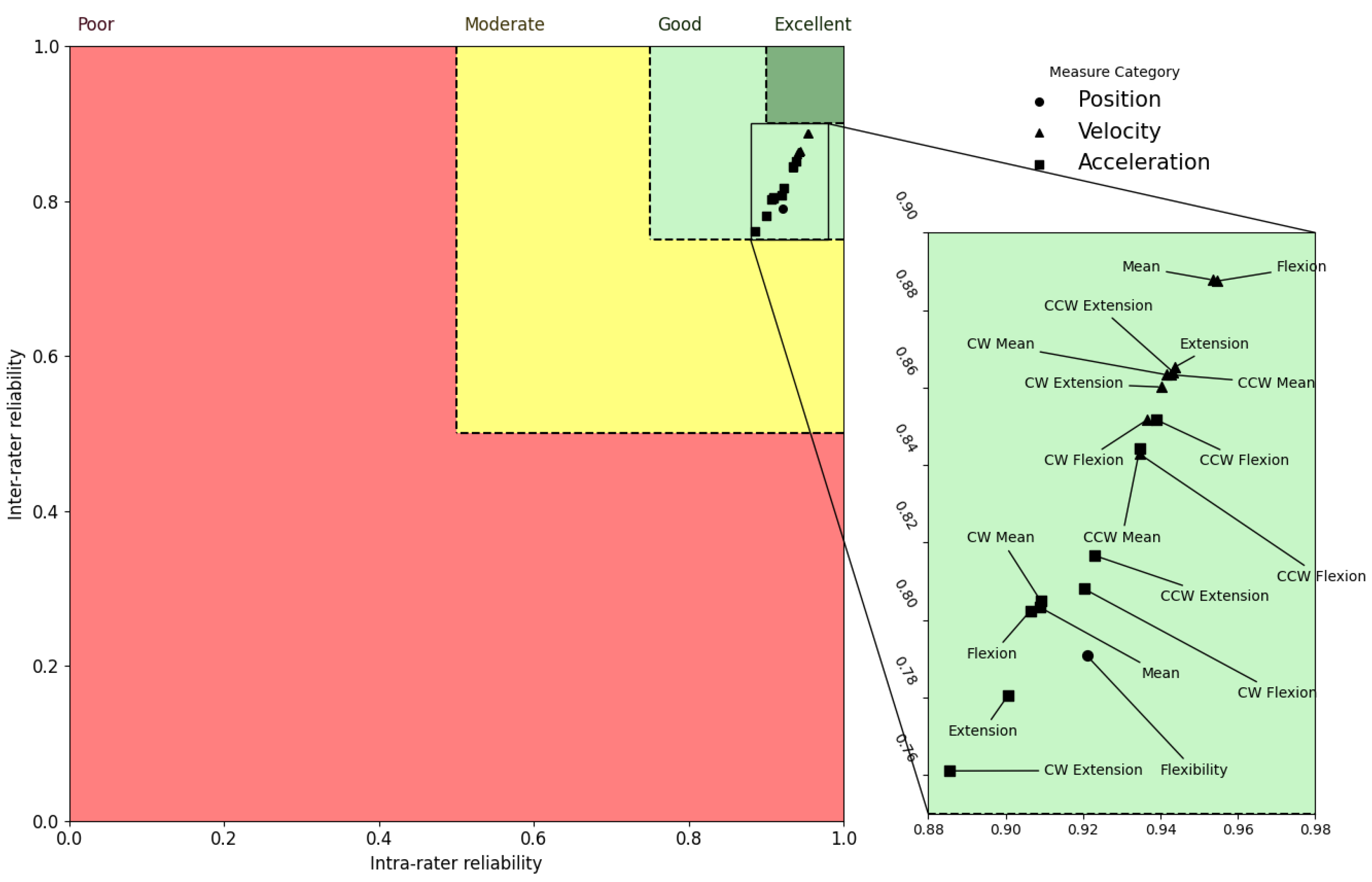Reliability of a Wearable Motion Tracking System for the Clinical Evaluation of a Dynamic Cervical Spine Function
Abstract
1. Introduction
2. Materials and Methods
2.1. Subjects
2.1.1. Inclusion Criteria
2.1.2. Exclusion Criteria
2.2. Clinical Neck Motion Assessment
Platform Components
2.3. Study Design
2.4. Testing Procedures
2.5. Statistical Analysis
3. Results
3.1. Demographics
3.2. Intra-Rater Reliability
3.3. Inter-Rater Reliability
3.4. Trend of Reliability of Metrics
4. Discussion
5. Conclusions
Author Contributions
Funding
Institutional Review Board Statement
Informed Consent Statement
Data Availability Statement
Acknowledgments
Conflicts of Interest
Appendix A
| Movement | Interpretation |
|---|---|
| Axial (Figure A1a) | Rotating neck in a plane that separates the body’s upper and lower halves as much as possible; CCW or CW |
| Lateral (Figure A1b) | Rotating neck in a plane that separates the body’s front and back halves as much as possible; CCW or CW |
| CCW Sagittal (Figure A1c) | Rotating neck in a plane that separates the body’s upper and lower halves as much as possible; CCW and performing the sagittal movement |
| CW Sagittal (Figure A1d) | Rotating neck in a plane that separates the body’s upper and lower halves as much as possible; CW and performing the sagittal movement |
| Sagittal (Figure A1e) | Tilting neck in a plane that separates the body’s CCW and CW halves as much as possible (forward) |
| Flexibility trial (Figure A2a) | A trial in which any rotational motion is performed for one cycle in a controlled manner as far as comfortably possible to achieve an extreme rotational position |
| Motion trial (Figure A2b) | A trial in which any rotational motion is performed; involves multiple cycles as fast as comfortably possible to achieve extreme rotational speed and acceleration |
| Feature | Description |
|---|---|
| CW Axial Flexibility | How far the CW subject twists in the axial plane |
| CCW Axial Flexibility | How far the CCW subject twists in the axial plane |
| Mean Axial Flexibility | The mean absolute (regardless of direction) flexibility in the axial plane collectively in both CCW and CW directions |
| CW Axial Velocity | Peak velocity of the subject twists CW in the axial plane |
| CCW Axial Velocity | Peak velocity of the subject twists CCW in the axial plane |
| Mean Axial Velocity | The mean absolute (regardless of direction) peak velocity in the axial plane in both CCW and CW directions |
| CW Axial Acceleration | Peak acceleration while twisting CW in the axial plane |
| CCW Axial Acceleration | Peak acceleration while twisting CCW in the axial plane |
| Mean Axial Acceleration | Mean peak absolute (regardless of direction) acceleration in the axial plane in the CCW and CW directions |
| Right Lateral Flexibility | How far to the subject’s right the subject bends in the lateral plane |
| Left Lateral Flexibility | How far to the subject’s left the subject bends in the lateral plane |
| Mean Lateral Flexibility | The mean (regardless of direction) flexibility in the lateral plane in both the left and right directions |
| Right Lateral Velocity | The peak velocity when a subject bends to the right side in the lateral plane |
| Left Lateral Velocity | The peak velocity when a subject bends to the left side in the lateral plane |
| Mean Lateral Velocity | The mean peak absolute (regardless of direction) velocity in the lateral plane while a subject bends at both the left and right sides |
| Right Lateral Acceleration | The peak acceleration when the subject bends to the right side of the lateral plane |
| Left Lateral Acceleration | The peak acceleration when the subject bends to the left in the lateral plane |
| Mean Lateral Acceleration | The mean absolute (regardless of direction) peak acceleration in the lateral plane in both the left and right sides |
| Flexion Sagittal Flexibility | How far forward the subject can bend in the sagittal plane |
| Flexion Sagittal Velocity | The peak velocity as the subject bends forward in the sagittal plane |
| Extension Sagittal Velocity | The peak velocity as the subject bends back to neutral from a flexed position in the sagittal plane |
| Mean Sagittal Velocity | The mean peak velocity when the subject bends forward and back to neutral in the sagittal plane |
| Flexion Sagittal Acceleration | The peak acceleration as the subject bends forward in the sagittal plane |
| Extension Sagittal Acceleration | The peak acceleration as the subject bends back to neutral from flexion in the sagittal plane |
| Mean Sagittal Acceleration | The mean absolute (regardless of direction) peak acceleration when a subject bends forward and back to neutral in the sagittal plane |
| CCW Sagittal Flexion Velocity | The peak velocity as the subject bends forward in the sagittal plane from a neutral position with a fully twisted CCW |
| CCW Sagittal Extension Velocity | The peak velocity as the subject bends back to neutral from a flexed position in the sagittal plane with a fully twisted CCW |
| CCW Sagittal Mean Velocity | The mean peak velocity as the subject bends forward and back to neutral in the sagittal plane with a fully twisted CCW |
| CCW Sagittal Flexion Acceleration | The peak acceleration as the subject bends forward in the sagittal plane with a fully twisted CCW |
| CCW Sagittal Extension Acceleration | The peak acceleration as the subject bends back to neutral in the sagittal plane with a fully twisted CCW |
| CCW Sagittal Mean Acceleration | The mean peak acceleration as the subject bends forward and back to neutral in the sagittal plane with a fully twisted CCW |
| CW Sagittal Flexion Velocity | The peak velocity as the subject bends forward in the sagittal plane while with a twisted CW |
| CW Sagittal Extension Velocity | The peak velocity as the subject bends back to neutral in the sagittal plane with a fully twisted CW |
| CW Sagittal Mean Velocity | The peak velocity as the subject bends forward and back to neutral in the sagittal plane with a fully twisted CW |
| CW Sagittal Flexion Acceleration | The peak acceleration as the subject bends forward in the sagittal plane with a fully twisted CW |
| CW Sagittal Extension Acceleration | The peak acceleration as the subject bends back to neutral in the sagittal plane with a fully twisted CW |
| CW Sagittal Mean Acceleration | The peak absolute (regardless of direction) acceleration as the subject bends forward and back to neutral in the sagittal plane with a fully twisted CW |


References
- Cohen, S.P. Epidemiology, Diagnosis, and Treatment of Neck Pain. Mayo Clin. Proc. 2015, 90, 284–299. [Google Scholar] [CrossRef] [PubMed]
- Misailidou, V.; Malliou, P.; Beneka, A.; Karagiannidis, A.; Godolias, G. Assessment of patients with neck pain: A review of definitions, selection criteria, and measurement tools. J. Chiropr. Med. 2010, 9, 49–59. [Google Scholar] [CrossRef] [PubMed]
- Kaufman, K.R.; An, K.N.; Chao, E.Y. A comparison of intersegmental joint dynamics to isokinetic dynamometer measurements. J. Biomech. 1995, 28, 1243–1256. [Google Scholar] [CrossRef] [PubMed]
- Sung, K.H.; Chung, C.Y.; Lee, K.M.; Kwon, K.B.; Lee, J.H.; Park, M.S. Discrepancy between true ankle dorsiflexion and gait kinematics and its association with severity of planovalgus foot deformity. BMC Musculoskelet. Disord. 2020, 21, 250. [Google Scholar] [CrossRef] [PubMed]
- de Marche Baldon, R.; Lobato, D.F.M.; Carvalho, L.P.; Santiago, P.R.P.; Benze, B.G.; Serrão, F.V. Relationship Between Eccentric Hip Torque and Lower-Limb Kinematics: Gender Differences. J. Appl. Biomech. 2011, 27, 223–232. [Google Scholar] [CrossRef] [PubMed]
- Godfrey, A.; Hetherington, V.; Shum, H.; Bonato, P.; Lovell, N.; Stuart, S. From A to Z: Wearable technology explained. Maturitas 2018, 113, 40–47. [Google Scholar] [CrossRef] [PubMed]
- Parast, M.M. The effect of Six Sigma projects on innovation and firm performance. Int. J. Proj. Manag. 2011, 29. [Google Scholar] [CrossRef]
- Bajpai, S.; Bajpai, R.; Chaturvedi, H. Evaluation of Inter-Rater Agreement and Inter-Rater Reliability for Observational Data: An Overview of Concepts and Methods. J. Indian Acad. Appl. Psychol. 2015, 41, 20–27. [Google Scholar]
- Maynard, V.; Bakheit, A.; Oldham, J.; Freeman, J. Intra-rater and inter-rater reliability of gait measurements with CODA mpx30 motion analysis system. Gait Posture 2003, 17, 59–67. [Google Scholar] [CrossRef]
- Lee, W.; Lin, J.H.; Bao, S. Inter-rater reliability of an inertial measurement unit sensor-based posture-matching method: A pilot study. Int. J. Ind. Ergon. 2020, 80, 103025. [Google Scholar] [CrossRef]
- Landis, J.R.; Koch, G.G. The measurement of observer agreement for categorical data. Biometrics 1977, 33, 159–174. [Google Scholar] [CrossRef] [PubMed]
- McGraw, K.O.; Wong, S.P. Forming inferences about some intraclass correlation coefficients. Psychol. Methods 1996, 1, 30–46. [Google Scholar] [CrossRef]
- Yoon, T.L.; Kim, H.N.; Min, J.H. Validity and Reliability of an Inertial Measurement Unit–based 3-Dimensional Angular Measurement of Cervical Range of Motion. J. Manip. Physiol. Ther. 2019, 42, 75–81. [Google Scholar] [CrossRef] [PubMed]
- Carmona-Pérez, C.; Garrido-Castro, J.L.; Vidal, F.T.; Alcaraz-Clariana, S.; García-Luque, L.; Alburquerque-Sendín, F.; de Souza, D.P.R. Concurrent Validity and Reliability of an Inertial Measurement Unit for the Assessment of Craniocervical Range of Motion in Subjects with Cerebral Palsy. Diagnostics 2020, 10, 80. [Google Scholar] [CrossRef]
- Chalimourdas, A.; Dimitriadis, Z.; Kapreli, E.; Strimpakos, N. Test—Re-test reliability and concurrent validity of cervical active range of motion in young asymptomatic adults using a new inertial measurement unit device. Expert Rev. Med. Devices 2021, 18, 1029–1037. [Google Scholar] [CrossRef]
- Marras, W.S.; Ferguson, S.A.; Gupta, P.; Bose, S.; Parnianpour, M.; Kim, J.Y.; Crowell, R.R. The Quantification of Low Back Disorder Using Motion Measures. Spine 1999, 24, 2091. [Google Scholar] [CrossRef]
- Wittmann, F.; Lambercy, O.; Gassert, R. Magnetometer-Based Drift Correction During Rest in IMU Arm Motion Tracking. Sensors 2019, 19, 1312. [Google Scholar] [CrossRef] [PubMed]
- Hani, H.; Souchereau, R.; Kachlan, A.; Harris, H.; Dufour, J.; Aurand, A.; Mageswaran, P.; Hyer, M.; Marras, W. Reliability of a Wearable Motion System for Clinical Evaluation of Dynamic Lumbar Spine Function. Adv. Complement. Alt. Med. 2022, 7, 672–683. [Google Scholar] [CrossRef]
- Marras, W.S.; Parnianpour, M.; Ferguson, S.A.; Kim, J.Y.; Crowell, R.R.; Bose, S.; Simon, S.R. The Classification of Anatomic- and Symptom-based Low Back Disorders Using Motion Measure Models. Spine 1995, 20, 2531–2546. [Google Scholar] [CrossRef] [PubMed]
- Dufour, J.S.; Aurand, A.M.; Weston, E.B.; Haritos, C.N.; Souchereau, R.A.; Marras, W.S. Dynamic Joint Motions in Occupational Environments as Indicators of Potential Musculoskeletal Injury Risk. J. Appl. Biomech. 2021, 37, 196–203. [Google Scholar] [CrossRef]
- Koo, T.K.; Li, M.Y. A Guideline of Selecting and Reporting Intraclass Correlation Coefficients for Reliability Research. J. Chiropr. Med. 2016, 15, 155–163. [Google Scholar] [CrossRef] [PubMed]
- Marras, W.S.; Ferguson, S.A.; Burr, D.; Davis, K.G.; Gupta, P. Functional impairment as a predictor of spine loading. Spine 2005, 30, 729–737. [Google Scholar] [CrossRef] [PubMed]
- Fletcher, J.P.; Bandy, W.D. Intrarater Reliability of CROM Measurement of Cervical Spine Active Range of Motion in Persons With and Without Neck Pain. J. Orthop. Sport. Phys. Ther. 2008, 38, 640–645. [Google Scholar] [CrossRef]
- Anoro-Hervera, A.; Lafuente-Pérez, A.; Navarro-Fernández, G.; Muñoz-García, D.; Lerma-Lara, S.; Beltran-Alacreu, H. Intra-rater and inter-rater reliability of cervical active range of movement in young asymptomatic adults using inertial sensors. Expert Rev. Med. Devices 2019, 16, 1071–1077. [Google Scholar] [CrossRef] [PubMed]
- Audette, I.; Dumas, J.P.; Côté, J.N.; Serres, S.J.D. Validity and Between-Day Reliability of the Cervical Range of Motion (CROM) Device. J. Orthop. Sport. Phys. Ther. 2010, 40, 318–323. [Google Scholar] [CrossRef]
- Stenneberg, M.S.; Busstra, H.; Eskes, M.; van Trijffel, E.; Cattrysse, E.; Scholten-Peeters, G.G.; de Bie, R.A. Concurrent validity and inter-rater reliability of a new smartphone application to assess 3D active cervical range of motion in patients with neck pain. Musculoskelet. Sci. Pract. 2018, 34, 59–65. [Google Scholar] [CrossRef]
- Petersen, C.; Johnson, R.; Schuit, D. Reliability of cervical range of motion using the OSI CA 6000 Spine Motion Analyser on asymptomatic and symptomatic subjects. Man. Ther. 2000, 5, 82–88. [Google Scholar] [CrossRef]




| Recording | 1 | 2 | 3 | 4 | 5 | 6 | 7 | 8 | 9 |
| Day | 1 | 2 | 3 | ||||||
| Test | 1 | 2 | 3 | 1 | 2 | 3 | 1 | 2 | 3 |
| Rater | I | II | III | II | III | I | III | I | II |
| Characteristics | Mean (Std) or n (%) |
|---|---|
| Age | |
| 18–20 | 1 (5%) |
| 20–25 | 8 (40%) |
| 25–30 | 2 (10%) |
| 30–35 | 3 (15%) |
| 35–40 | 1 (5%) |
| 40–45 | - |
| 45–50 | - |
| 50–55 | 2 (10%) |
| 55–60 | 1 (5%) |
| Over 60 | 2 (10%) |
| Gender | |
| Female | 10 (50%) |
| Male | 10 (50%) |
| Race | |
| Asian | 5 (25%) |
| Caucasian | 14 (70%) |
| Unspecified | 1 (5%) |
| Height and Weight | |
| Height (cm) | 171.5 (9.6) |
| Weight (kg) | 69.8 (11.9) |
| Measure | ICC | 95% Confidence Intervals | |
|---|---|---|---|
| Interval Low (2.5%) | Interval High (97.5%) | ||
| CW Axial Flexibility | 0.93 | 0.87 | 0.97 |
| CCW Axial Flexibility | 0.92 | 0.84 | 0.96 |
| Mean Axial Flexibility | 0.94 | 0.9 | 0.97 |
| CW Axial Velocity | 0.94 | 0.89 | 1 |
| CCW Axial Velocity | 0.94 | 0.89 | 1 |
| Mean Axial Velocity | 0.94 | 0.89 | 1 |
| CW Axial Acceleration | 0.9 | 0.79 | 1 |
| CCW Axial Acceleration | 0.92 | 0.83 | 1 |
| Mean Axial Acceleration | 0.92 | 0.82 | 1 |
| Right Lateral Flexibility | 0.93 | 0.87 | 0.96 |
| Left Lateral Flexibility | 0.92 | 0.84 | 0.96 |
| Mean Lateral Flexibility | 0.94 | 0.88 | 0.97 |
| Right Lateral Velocity | 0.9 | 0.84 | 0.94 |
| Left Lateral Velocity | 0.9 | 0.85 | 1 |
| Mean Lateral Velocity | 0.9 | 0.85 | 0.96 |
| Right Lateral Acceleration | 0.85 | 0.77 | 0.93 |
| Left Lateral Acceleration | 0.89 | 0.81 | 1 |
| Mean Lateral Acceleration | 0.88 | 0.8 | 1 |
| Flexion Sagittal Flexibility | 0.92 | 0.88 | 0.95 |
| Flexion Sagittal Velocity | 0.95 | 0.93 | 1 |
| Extension Sagittal Velocity | 0.94 | 0.91 | 1 |
| Mean Sagittal Velocity | 0.95 | 0.92 | 1 |
| Flexion Sagittal Acceleration | 0.91 | 0.85 | 1 |
| Extension Sagittal Acceleration | 0.9 | 0.85 | 1 |
| Mean Sagittal Acceleration | 0.91 | 0.86 | 1 |
| CCW Sagittal Flexion Velocity | 0.93 | 0.9 | 1 |
| CCW Sagittal Extension Velocity | 0.94 | 0.91 | 1 |
| CCW Sagittal Mean Velocity | 0.94 | 0.91 | 1 |
| CCW Sagittal Flexion Acceleration | 0.94 | 0.9 | 1 |
| CCW Sagittal Extension Acceleration | 0.92 | 0.88 | 1 |
| CCW Sagittal Mean Acceleration | 0.93 | 0.89 | 1 |
| CW Sagittal Flexion Velocity | 0.94 | 0.91 | 1 |
| CW Sagittal Extension Velocity | 0.94 | 0.91 | 1 |
| CW Sagittal Mean Velocity | 0.94 | 0.91 | 1 |
| CW Sagittal Flexion Acceleration | 0.92 | 0.87 | 1 |
| CW Sagittal Extension Acceleration | 0.89 | 0.82 | 1 |
| CW Sagittal Mean Acceleration | 0.91 | 0.85 | 1 |
| Feature | ICC | 95% Confidence Intervals | |
|---|---|---|---|
| Interval Low (2.5%) | Interval High (97.5%) | ||
| CW Axial Flexibility | 0.83 | 0.71 | 0.9 |
| CCW Axial Flexibility | 0.8 | 0.65 | 0.89 |
| Mean Axial Flexibility | 0.86 | 0.76 | 0.92 |
| CW Axial Velocity | 0.87 | 0.77 | 1 |
| CCW Axial Velocity | 0.86 | 0.76 | 1 |
| Mean Axial Velocity | 0.87 | 0.77 | 1 |
| CW Axial Acceleration | 0.79 | 0.6 | 1 |
| CCW Axial Acceleration | 0.83 | 0.66 | 1 |
| Mean Axial Acceleration | 0.82 | 0.64 | 1 |
| Right Lateral Flexibility | 0.82 | 0.7 | 0.89 |
| Left Lateral Flexibility | 0.8 | 0.66 | 0.88 |
| Mean Lateral Flexibility | 0.85 | 0.74 | 0.92 |
| Right Lateral Velocity | 0.78 | 0.68 | 0.87 |
| Left Lateral Velocity | 0.78 | 0.69 | 1 |
| Mean Lateral Velocity | 0.79 | 0.69 | 1 |
| Right Lateral Acceleration | 0.7 | 0.58 | 0.85 |
| Left Lateral Acceleration | 0.75 | 0.6 | 1 |
| Mean Lateral Acceleration | 0.74 | 0.6 | 1 |
| Flexion Sagittal Flexibility | 0.79 | 0.7 | 0.86 |
| Flexion Sagittal Velocity | 0.89 | 0.82 | 1 |
| Extension Sagittal Velocity | 0.87 | 0.79 | 1 |
| Mean Sagittal Velocity | 0.89 | 0.82 | 1 |
| Flexion Sagittal Acceleration | 0.8 | 0.69 | 1 |
| Extension Sagittal Acceleration | 0.78 | 0.68 | 1 |
| Mean Sagittal Acceleration | 0.8 | 0.7 | 1 |
| CCW Sagittal Flexion Velocity | 0.84 | 0.77 | 1 |
| CCW Sagittal Extension Velocity | 0.86 | 0.79 | 1 |
| CCW Sagittal Mean Velocity | 0.86 | 0.79 | 1 |
| CCW Sagittal Flexion Acceleration | 0.85 | 0.77 | 1 |
| CCW Sagittal Extension Acceleration | 0.82 | 0.73 | 1 |
| CCW Sagittal Mean Acceleration | 0.84 | 0.76 | 1 |
| CW Sagittal Flexion Velocity | 0.85 | 0.79 | 1 |
| CW Sagittal Extension Velocity | 0.86 | 0.78 | 1 |
| CW Sagittal Mean Velocity | 0.86 | 0.8 | 1 |
| CW Sagittal Flexion Acceleration | 0.81 | 0.71 | 1 |
| CW Sagittal Extension Acceleration | 0.76 | 0.65 | 1 |
| CW Sagittal Mean Acceleration | 0.8 | 0.7 | 1 |
Disclaimer/Publisher’s Note: The statements, opinions and data contained in all publications are solely those of the individual author(s) and contributor(s) and not of MDPI and/or the editor(s). MDPI and/or the editor(s) disclaim responsibility for any injury to people or property resulting from any ideas, methods, instructions or products referred to in the content. |
© 2023 by the authors. Licensee MDPI, Basel, Switzerland. This article is an open access article distributed under the terms and conditions of the Creative Commons Attribution (CC BY) license (https://creativecommons.org/licenses/by/4.0/).
Share and Cite
Hani, H.; Souchereau, R.; Kachlan, A.; Dufour, J.; Aurand, A.; Mageswaran, P.; Hyer, M.; Marras, W. Reliability of a Wearable Motion Tracking System for the Clinical Evaluation of a Dynamic Cervical Spine Function. Sensors 2023, 23, 1448. https://doi.org/10.3390/s23031448
Hani H, Souchereau R, Kachlan A, Dufour J, Aurand A, Mageswaran P, Hyer M, Marras W. Reliability of a Wearable Motion Tracking System for the Clinical Evaluation of a Dynamic Cervical Spine Function. Sensors. 2023; 23(3):1448. https://doi.org/10.3390/s23031448
Chicago/Turabian StyleHani, Hamed, Reid Souchereau, Anas Kachlan, Jonathan Dufour, Alexander Aurand, Prasath Mageswaran, Madison Hyer, and William Marras. 2023. "Reliability of a Wearable Motion Tracking System for the Clinical Evaluation of a Dynamic Cervical Spine Function" Sensors 23, no. 3: 1448. https://doi.org/10.3390/s23031448
APA StyleHani, H., Souchereau, R., Kachlan, A., Dufour, J., Aurand, A., Mageswaran, P., Hyer, M., & Marras, W. (2023). Reliability of a Wearable Motion Tracking System for the Clinical Evaluation of a Dynamic Cervical Spine Function. Sensors, 23(3), 1448. https://doi.org/10.3390/s23031448







